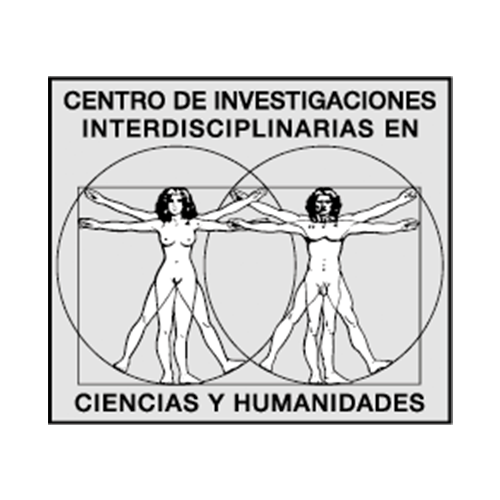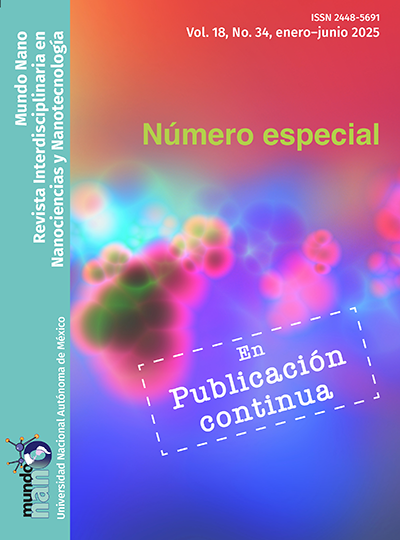Nanomateriales carbonosos y óxido de silicio para la remoción de toxinas urémicas: una revisión
Conteúdo do artigo principal
Resumo
La enfermedad renal crónica es un problema de salud global que afecta a millones de personas en todo el mundo. Uno de los tratamientos más comunes para esta condición es la hemodiálisis, que implica la eliminación de toxinas urémicas del torrente sanguíneo mediante un sistema extracorpóreo. Sin embargo, la eficacia de la hemodiálisis puede verse limitada por la presencia de toxinas urémicas de bajo peso molecular difíciles de eliminar mediante técnicas convencionales. En los últimos años, se ha investigado el uso de nanomateriales carbonosos y óxido de silicio como adsorbentes para la remoción de estas toxinas, debido a sus propiedades únicas de alta superficie y capacidad de adsorción. Estos materiales representan una nueva y prometedora clase de adsorbentes para la remoción de toxinas urémicas en pacientes con insuficiencia renal crónica, que mejoren el porcentaje de remoción en la sangre y aumenten la calidad de vida de los pacientes. En esta revisión, se presenta un análisis detallado de los avances más recientes en el uso de nanomateriales carbonosos y óxido de silicio para la remoción de toxinas urémicas, así como los avances más recientes en este campo, con un enfoque en los mecanismos de adsorción y la eficacia de remoción.
Downloads
Detalhes do artigo

Mundo Nano. Revista Interdisciplinaria en Nanociencias y Nanotecnología, editada por la Universidad Nacional Autónoma de México, se distribuye bajo una Licencia Creative Commons Atribución-NoComercial 4.0 Internacional.
Basada en una obra en http://www.mundonano.unam.mx.
Referências
Akchurin, O. M. (2019). Chronic kidney disease and dietary measures to improve outcomes. Pediatric Clinics of North America, 66(1): 247-267. https://doi.org/10.1016/j.pcl.2018.09.007. DOI: https://doi.org/10.1016/j.pcl.2018.09.007
Alvarado, C. et al. (2019). Graphene nanoplatelets modified with amino-groups by ultrasonic radiation of variable frequency for potential adsorption of uremic toxins. Nanomaterials, 9(9): 1261. https://doi.org/10.3390/nano9091261. DOI: https://doi.org/10.3390/nano9091261
Alvarado, C. et al. (2022). Non-woven fabrics based on nylon 6/carbon black-graphene nanoplatelets obtained by melt-blowing for adsorption of urea, uric acid and creatinine. Material Letters, 320: 132382. Elservier. https://doi.org/10.1016/j.matlet.2022.132382. DOI: https://doi.org/10.1016/j.matlet.2022.132382
Andrade-Guel, M. L., Cabello-Alvarado, Ch., Cruz-Delgado, V. J., Bartolo-Pérez, P., De León-Martínez, P. A., Sáenz-Galindo, A., Cadenas-Pliego, G., Ávila-Orta, C. A. (2019). Surface modification of graphene nanoplatelets by organic acids and ultrasonic radiation for enhance uremic toxins adsorption. México. https://doi.org/10.3390/ma12050715. DOI: https://doi.org/10.3390/ma12050715
Andreoli, M. C. C. y Totoli, C. (2020). Peritoneal dialysis. Revista Da Associacao Medica Brasileira (1992): 66(Suppl 1): s37-s44. https://doi.org/10.1590/1806-9282.66.S1.37. DOI: https://doi.org/10.1590/1806-9282.66.s1.37
Andrews, R., Jacques, D., Minot, M., Rantell, T., Saini, R. K. y Loadmann, M. (2002). Fabrication of carbon multiwall nanotube/polymer composites by shear mixing. Macromolecular Materials and Engineering, 287(6): 395-403. https://doi.org/10.1002/1439-2054(20020601)287:6%3C395::AID-MAME395%3E3.0.CO;2-S. DOI: https://doi.org/10.1002/1439-2054(20020601)287:6<395::AID-MAME395>3.0.CO;2-S
Argaiz, E. R., Morales-Juárez, L., Razo, C., Ong, L., Rafferty, Q., Rincón-Pedrero, R. y Gamba, G. (2023). La carga de enfermedad renal crónica en México. Análisis de datos basado en el estudio. Global burden of disease. Gaceta Médica de México, 159(6). https://doi.org/10.24875/GMM.23000393. DOI: https://doi.org/10.24875/GMM.23000393
Ávila-Saldívar, M. N., Conchillos-Olivares, G., Rojas-Báez, I. C., Elizabeth, A. (2013) Enfermedad renal crónica: causa y prevalencia en la población del Hospital General La Perla. Med. Interna Mex. 29 (5): 473-478.
Baughman, R. H., Zakhidov, A. A. y de Heer, W. A. (2002). Carbon nanotubes — The route toward applications. Science, 297(5582): 787-792. https://doi.org/10.1126/science.1060928. DOI: https://doi.org/10.1126/science.1060928
Bawendi, M. G., Steigerwald, M. L. y Brus, L. E. (1990). The quantum mechanics of larger semiconductor clusters (“quantum dots”). Annual Review of Physical Chemistry, 41(1): 477-496. https://doi.org/10.1146/annurev.pc.41.100190.002401. DOI: https://doi.org/10.1146/annurev.pc.41.100190.002401
Bhattacharyya, S. y Singh, S. (2019). Nanotechnology: exploring concepts, potential applications, and their implications. Nano Today, 25: 10-24. DOI: https://doi.org/10.1016/j.nantod.2018.11.002
Bhushan, B. (2017). Introduction to nanotechnology. En Springer handbook of nanotechnology. Springer, 1-10. DOI: https://doi.org/10.1007/978-3-662-54357-3_1
Cai Q., Luo Z. S., Pang, W. Q., Fan, Y. W., Chen, X. H., Cui, F. Z. (2006). Biocompatibility of a mesoporous silica nanoparticle (MSN)-carbon nanotube (CNT) composite with endothelial cells. J Nanosci Nanotechnol, 6(3): 785-91. https://doi.org/10.1166/jnn.2006.163.
Cheah, W.-K., Sim, Y.-L. y Yeoh, F.-Y. (2016). Amine-functionalized mesoporous silica for urea adsorption. Materials Chemistry and Physics, 175: 151-157. https://doi.org/10.1016/j.matchemphys.2016.03.007. DOI: https://doi.org/10.1016/j.matchemphys.2016.03.007
Chen, H., Li, J., Shao, D., Ren, X. y Wang, X. (2012). Poly (acrylic acid) grafted multiwall carbon nanotubes by plasma techniques for Co(II) removal from aqueous solution. Chemical Engineering Journal, 210: 475-481. https://doi.org/10.1016/j.cej.2012.08.082. DOI: https://doi.org/10.1016/j.cej.2012.08.082
Chu, K. H., Bashiri, H., Hashim, M. A., Abd Shukor, M. Y. y Bollinger, J.-C. (2023). The Halsey isotherm for water contaminant adsorption is fake. Separation and Purification Technology, 313: 123500. https://doi.org/10.1016/j.seppur.2023.123500. DOI: https://doi.org/10.1016/j.seppur.2023.123500
Coleman, J. N., Khan, U., Blau, W. J. y Gun’ko, Y. K. (2006). Small but strong: a review of the mechanical properties of carbon nanotube-polymer composites. Carbon, 44(9): 1624-1652. https://doi.org/10.1016/j.carbon.2006.02.038. DOI: https://doi.org/10.1016/j.carbon.2006.02.038
Ding, S., Wang, D. y Wang, X. (2022). Hierarchically structural layered double oxides with stretchable nanopores for highly effective removal of protein-bound uremic toxins. Separation and Purification Technology, 301: 122033. https://doi.org/10.1016/j.seppur.2022.122033. DOI: https://doi.org/10.1016/j.seppur.2022.122033
DOF. (2022). Acuerdo Número ACDO.AS3.HCT.251121/301.P.DF. Aprobación de los costos unitarios por nivel de atención medica actualizada al 2022. Diario Oficial de la Federación (DOF). México. https://www.dof.gob.mx/nota_detalle.php?codigo=5672661&fecha=29/11/2022.
Donaldson, K. y Stone, V. (2003). Current hypotheses on the mechanisms of toxicity of ultrafine particles. Annali Dell’Istituto Superiore Di Sanita, 39(3): 405-410.
Dresselhaus, M. S., Dresselhaus, G. y Eklund, P. C. (1996). Science of fullerenes and carbon nanotubes: their properties and applications. Academic Press. https://doi.org/10.1021/ja965593l. DOI: https://doi.org/10.1016/B978-012221820-0/50013-7
Duranton, F., Cohen, G., De Smet, R., Rodríguez, M., Jankowski, J., Vanholder, R. et al. (2012). Normal and pathologic concentrations of uremic toxins. J Am Soc Nephrol., 23(7): 1258-1270. https://doi.org/10.1681/ASN.2011121175. DOI: https://doi.org/10.1681/ASN.2011121175
Dykman, L. A. y Khlebtsov, N. G. (2012). Gold nanoparticles in biomedical applications: recent advances and perspectives. Chemical Society Reviews, 41(6): 2256-2282. https://doi.org/10.1039/C1CS15166E. DOI: https://doi.org/10.1039/C1CS15166E
El-Khatib, E. M. (2012). Antimicrobial and self-cleaning textiles using nanotechnology. Research Journal of Textile and Apparel, 16(3): 156-174. https://doi.org/10.1108/RJTA-16-03-2012-B016. DOI: https://doi.org/10.1108/RJTA-16-03-2012-B016
Evans, M., Lewis, R. D., Morgan, A. R., Whyte, M. B., Hanif, W., Bain, S. C., Davies, S., Dashora, U., Yousef, Z., Patel, D. C. y Strain, W. D. (2022). A narrative review of chronic kidney disease in clinical practice: current challenges and future perspectives. Advances in Therapy, 39(1): 33-43. https://doi.org/10.1007/s12325-021-01927-z. DOI: https://doi.org/10.1007/s12325-021-01927-z
Evenepoel, P., Meijers, B. K. I., Bammens, B. R. M., Verbeke, K. (2009). Uremic toxins originating from colonic microbial metabolism. Kidney Int Suppl., 76 (Suppl 114): S12-S19. https://doi.org/10.1038/ki.2009.402. DOI: https://doi.org/10.1038/ki.2009.402
Feng, X., Chen, A., Zhang, Y., Wang, J., Shao, L. et al. (2018). Silica nanocapsules with ultralarge pores for the removal of low–molecular weight uremic toxins. ACS Applied Materials & Interfaces, 10(6): v5465-5472. https://doi.org/10.1021/acsami.7b17197.
Ficheux, A., Kerr, P. G., Brunet, P. y Argiles, A. (2011). The ultrafiltration coefficient of a dialyser (KUF) is not a fixed value, and it follows a parabolic function: the new concept of KUF max. Nephrology Dialysis Transplantation, 26(2): 636-640. https://doi.org/10.1093/ndt/gfq510. DOI: https://doi.org/10.1093/ndt/gfq510
Gaitonde, D. Y., Cook, D. L., Rivera, I. M., (2017). Chronic kidney disease: detection and evaluation. American Family Physician, 96(12): 776-783.
Gao, C., Zhang, Q., Yang, Y., Li, Y. y Lin, W. (2022). Recent trends in therapeutic application of engineered blood purification materials for kidney disease. Biomaterials Research, 26(1). https://doi.org/10.1186/s40824-022-00250-0. DOI: https://doi.org/10.1186/s40824-022-00250-0
Geim, A. K. y Novoselov, K. S. (2007). The rise of graphene. Nature materials, 6(3): 183-191. DOI: https://doi.org/10.1038/nmat1849
Giraldo, Y. G., Fernández, E. M. B., Muñoz, R. G., López, C. M. D. y Bouarich, H. (2023). Chronic kidney disease (I). Aetiopathogenisis, clinical manifestations, diagnosis and prognosis. Medicine - Accredited Continuing Medical Training Program, 13(80): 4730-4737. https://doi.org/10.1016/j.med.2023.05.012. DOI: https://doi.org/10.1016/j.med.2023.05.012
Goicoechea, M. (2021). Ácido úrico y enfermedad renal crónica: afectación renal en las enfermedades sistémicas. Servicio de Nefrología. Hospital General Universitario Gregorio Marañón. Madrid. https://www.nefrologiaaldia.org/es-articulo-acido-urico-enfermedad-renal-cronica-200.
Guerreiro, J. F., Pereira da Silva, M., Bordonhos, M., Minhalma, M., Pinto, M. L. y De Pinho, M. N. (2023). Synthesis and characterization of MOF/silica cellulose acetate-based membranes: removal of uremic toxins in haemodialysis spent dialysate. Desalination, 565: 116860. https://doi.org/10.1016/j.desal.2023.116860. DOI: https://doi.org/10.1016/j.desal.2023.116860
Gupta, A. K. y Gupta, M. (2005). Synthesis and surface engineering of iron oxide nanoparticles for biomedical applications. Biomaterials, 26(18): 3995-4021. https://doi.org/10.1016/j.biomaterials.2004.10.012. DOI: https://doi.org/10.1016/j.biomaterials.2004.10.012
Henao, V. C. (2010). Enfermedad renal crónica. En Nefrología básica 2. Colombia, 189- 205.
Hernández, O. (2021). Alotropos. México. www.youtube.com/@prof.osvaldohernandez.
Hill, N. R., Fatoba, S. T., Oke, J. L., Hirst, J. A., O’Callaghan, C. A., Lasserson, D. S. y Hobbs, F. D. R. (2016). Global prevalence of chronic kidney disease – a systematic review and meta-analysis. PLoS One, 11(7): e0158765. https://doi.org/10.1371/journal.pone.0158765. DOI: https://doi.org/10.1371/journal.pone.0158765
Htay, H., Johnson, D. W., Craig, J. C., Teixeira Pinto, A., Hawley, C. M. y Cho, Y. (2021). Urgent start peritoneal dialysis versus haemodialysis for people with chronic kidney disease. Cochrane Database of Systematic Review, 1(1): CD012899, enero 27. https://doi.org/10.1002/14651858.CD012899.pub2. DOI: https://doi.org/10.1002/14651858.CD012899.pub2
Hu, J., Odom, T. W. y Lieber, C. M. (1999). Chemistry and physics in one dimension: synthesis and properties of nanowires and nanotubes. Accounts of Chemical Research, 32(5): 435-445. https://doi.org/10.1021/ar9700365. DOI: https://doi.org/10.1021/ar9700365
Huber, D. L. (2005). Synthesis, properties, and applications of iron nanoparticles. Small, 1(5): 482-501. https://doi.org/10.1002/smll.200500006. DOI: https://doi.org/10.1002/smll.200500006
INEGI (Instituto Nacional de Estadística y Geografía). (2023). Estadística de defunciones registradas de enero a junio 2022. Comunicado de prensa número 29: 1-40. https://www.inegi.org.mx/contenidos/saladeprensa/boletines/2024/EDR/EDR2023_En-Jn.pdf.
INSP (Instituto Nacional de Salud Pública). (2020). La enfermedad renal crónica en México. https://www.insp.mx/avisos/5296-enfermedad-renal-cronica-mexico.html.
Jha, V., García, G., Iseki, K., Li, Z., Naicker, S., Plattner, B. et al. (2013). Chronic kidney disease: global dimension and perspectives. The Lancet. 382(9888):260-72. https://doi.org/10.1016/S0140-6736(13)60687-X. DOI: https://doi.org/10.1016/S0140-6736(13)60687-X
Jiang, Q., Song, R., Xu, L., Tang, Y., Li, H., Cheng, Z. et al. (2020). Carbon-based nanomaterials for hemoperfusion: a mini-review. Frontiers in Chemistry, 8: 405. https://doi.org/10.3389/fchem.2020.00405.
K/DOQI. (2002). Clinical practice guidelines for chronic kidney disease: evaluation, classification, and stratification. National Kidney Foundation. Am J Kidney Dis, 39(suppl 1) 1: S1-266.
Kameda, T., Horikoshi, K., Kumagai, S., Saito, Y. y Yoshioka, T. (2020). Adsorption of urea, creatinine, and uric acid onto spherical activated carbon. Separation and Purification Technology, 237: 116367. https://doi.org/10.1016/j.seppur.2019.116367. DOI: https://doi.org/10.1016/j.seppur.2019.116367
Kausar, A., Iqbal, M., Javed, A., Aftab, K., Nazli, Z. H., Bhatti, H. N. y Nouren, S. (2018). Dyes adsorption using clay and modified clay: a review. Journal of Molecular Liquids, 256: 395-407. https://doi.org/10.1016/j.molliq.2018.02.034. DOI: https://doi.org/10.1016/j.molliq.2018.02.034
Kim, T., Hyeon, T. (2014). Applications of inorganic nanoparticles as therapeutic agents. Nanotechnology, 25(1): 012001. https://doi.org/10.1088/0957-4484/25/1/012001. DOI: https://doi.org/10.1088/0957-4484/25/1/012001
Kotanko, P., Kuhlmann, M. K. y Levin, N. W. (2010). Hemodialysis: principles and techniques. En Comprehensive clinical nephrology, 4th ed. Elsevier, 1053-1059. https://doi.org/10.1016/B978-0-323-05876-6.00089-7. DOI: https://doi.org/10.1016/B978-0-323-05876-6.00089-7
Laurent, S., Forge, D., Port, M., Roch, A., Robic, C., Vander Elst, L. y Muller, R. N. (2008). Magnetic iron oxide nanoparticles: synthesis, stabilization, vectorization, physicochemical characterizations, and biological applications. Chemical Reviews, 108(6): 2064-2110. https://doi.org/10.1021/cr068445e. DOI: https://doi.org/10.1021/cr068445e
Levey, A. S., Coresh, J. (2012) Chronic kidney disease. The Lancet, 379(9811): 165-180. https://doi.org/10.1016/S0140-6736(11)60178-5. DOI: https://doi.org/10.1016/S0140-6736(11)60178-5
Li, J., Li, X., Wang, X., Ye, Q., Zhai, K. et al. (2017). Removal of uremic toxins by mesoporous silica nanoparticles. Scientific Reports, 7: 8809. https://doi.org/10.1038/s41598-017-09368-2.
Li, J., Lu, Y., Ye, Q., Cinke, M., Han, J. y Meyyappan, M. (2003). Carbon nanotube sensors for gas and organic vapor detection. Nano letters, 3(7): 929-933. https://doi.org/10.1021/nl034220x. DOI: https://doi.org/10.1021/nl034220x
Liabeuf, S., Barreto, D. V., Barreto, F. C., Meert, N., Glorieux, G., Schepers, E. et al. (2010). Free p-cresylsulphate is a predictor of mortality in patients at different stages of chronic kidney disease. Nephrol Dial Transplant. 25(4): 1183-1191. https://doi.org/10.1093/ndt/gfp592. DOI: https://doi.org/10.1093/ndt/gfp592
Liabeuf, S., Glorieux, G., Lenglet, A., Diouf, M., Schepers, E., Desjardins, L. et al. (2013). Does p-cresylglucuronide have the same impact on mortality as other protein-bound uremic toxins? PLoS One. 8(6): e67168. https://doi.org/10.1371/journal.pone.0067168. DOI: https://doi.org/10.1371/journal.pone.0067168
Lijima, S. (1991). Helical microtubules of graphitic carbon. Nature, 354(6348): 56-58. https://doi.org/10.1038/354056a0. DOI: https://doi.org/10.1038/354056a0
Lin, Y. S., Hurley, K. R., Haynes, C. L. (2012). Critical considerations in the biomedical use of mesoporous silica nanoparticles. Journal of Physical Chemistry Letters, 3(3): 364-374. https://doi.org10.1021/jz2015164. DOI: https://doi.org/10.1021/jz2013837
Lin, Y., Xu, Z., Wang, Z., Wang, L., Lin, J., Yao, C. et al. (2016). Efficient removal of uremic toxin by functionalized nanoporous carbon: an in vitro study. ACS Applied Materials & Interfaces, 8(7): 4703-4711. https://doi.org/10.1021/acsami.5b12122.
Liu, Y., Peng, X., Hu, Z., Yu, M., Fu, J. y Huang, Y. (2021). Fabrication of a novel nitrogen-containing porous carbon adsorbent for protein-bound uremic toxins removal. Materials Science and Engineering: C, 121: 111879. https://doi.org/10.1016/j.msec.2021.111879. DOI: https://doi.org/10.1016/j.msec.2021.111879
López, D. E. (2008). Enfermedad renal crónica; definición y clasificación. El Residente, 3(3): 73-78. https://www.medigraphic.com/pdfs/residente/rr-2008/rr083b.pdf.
Lu, J., Liong, M., Zink, J. I., Tamanoi, F. (2007). Mesoporous silica nanoparticles as a delivery system for hydrophobic anticancer drugs. Small, 3(8): 1341-1346. https://doi.org10.1002/smll.200700012. DOI: https://doi.org/10.1002/smll.200700005
Lythe, J. E., Xue, H., Lynch, K. E., Curhan, G. C., Brunelli, S. M. (2015). Association of mortality risk with various definitions of intradialytic hypotension. Journal of the American Society of Nephrology, 26(3): 724-34. https://doi.org10.1681/ASN.2014020187. DOI: https://doi.org/10.1681/ASN.2014020222
Malik, D. J., Warwick, G. L., Mathieson, I., Hoenich, N. A. y Streat, M. (2005). Structured carbon haemoadsorbents for the removal of middle molecular weight toxins. Carbon, 43(11): 2317-2329. https://doi.org/10.1016/j.carbon.2005.04.038A. DOI: https://doi.org/10.1016/j.carbon.2005.04.038
Malik, S., Muhammad, K. y Waheed, Y. (2023). Nanotechnology: a revolution in modern industry. Molecules, 28(2): 661. https://doi.org/10.3390/molecules28020661. DOI: https://doi.org/10.3390/molecules28020661
Malo, M. A. y De Francisco, A. L. M. (2010). Dializadores y membranas de diálisis. Nefrología al día. Madrid: Grupo Editorial Nefrología de la Sociedad Española de Nefrología, 425-435.
Martín Martínez, J. Miguel. (1990). Adsorción física de gases y vapores por carbones. España: Universidad de Alicante.
Martínez, G., Guerra, E. y Pérez, D. (2020). Enfermedad renal crónica, algunas consideraciones actuales. Multimed, Revista Médica. Granma, 42(2), Cuba.
Miardan, L. N., Rezaii, E., Mahkam, M. y Khosroshahi, H. T. (2023). Synthesis of mesoporous silica nanoparticles linked by molecularly imprinted polymers and examination of their ability to remove uremic toxins. Journal of Porous Materials, 30(6): 1995-2010. https://doi.org/10.1007/s10934-023-01480-w. DOI: https://doi.org/10.1007/s10934-023-01480-w
Mosavi, S. H. y Zare-Dorabei, R. (2023). Synthesis of an IRMOF-1@SiO 2 core–shell and amino-functionalization with APTES for the adsorption of urea and creatinine using a fixed-bed column study. Langmuir, 39(18): 6623-6636. https://doi.org/10.1021/acs.langmuir.3c00632. DOI: https://doi.org/10.1021/acs.langmuir.3c00632
Mosleh-Shirazi, S., Abbasi, M., Moaddeli, M. Reza, Vaez, A., Shafiee, M., Kasaee, S. R., Amani, A. M. y Hatam, S. (2022). Nanotechnology advances in the detection and treatment of cancer: an overview. Nanotheranostics, 6(4): 400-423. https://doi.org/10.7150/ntn.74613. DOI: https://doi.org/10.7150/ntno.74613
Nguyen, C. H., Fu, C.-C., Chen, Z.-H., Tran, T. T. Van, Liu, S.-H. y Juang, R.-S. (2021). Enhanced and selective adsorption of urea and creatinine on amine-functionalized mesoporous silica SBA-15 via hydrogen bonding. Microporous and Mesoporous Materials, 311: 110733. https://doi.org/10.1016/j.micromeso.2020.110733. DOI: https://doi.org/10.1016/j.micromeso.2020.110733
Niang, A., Iyengar, A. y Luyckx, V. A. (2018). Hemodialysis versus peritoneal dialysis in resource limited settings. Current Opinion in Nephrology and Hypertension, 27(6): 463-471. https://doi.org/10.1097/MNH.0000000000000455. DOI: https://doi.org/10.1097/MNH.0000000000000455
Novoselov, K. S., Geim, A. K., Morozov, S. V., Jiang, D., Zhang, Y., Dubonos, S. V. y Firsov, A. A. (2004). Electric field effect in atomically thin carbon films. Science, 306(5696): 666-669. https://doi.org/10.1126/science.1102896. DOI: https://doi.org/10.1126/science.1102896
OMS (Organización Mundial de la Salud). (2020). Las 10 principales causas de muerte. https://www.who.int/news-room/fact-sheets/detail/thetop-10-causes-of-death.
Ooi, C. H., Cheah, W. K. y Yeoh, F. Y. (2019). Comparative study on the urea removal by different nanoporous materials. Adsorption, 25(6): 1169-1175. https://doi.org/10.1007/s10450-019-00130-5. DOI: https://doi.org/10.1007/s10450-019-00130-5
Padilla-Osuna, I. y Escobar-Leal, G. (2017). Alteraciones en el eje intestino-riñón durante la enfermedad renal crónica: causas, consecuencias y propuestas de tratamiento. https://dx.doi.org/10.14306/renhyd.21.2.244.
Pavlenko, D., Giasafaki, D., Charalambopoulou, G., Van Geffen, E., Gerritsen, K. G. F., Steriotis, T. y Stamatialis, D. (2017). Carbon adsorbents with dual porosity for efficient removal of uremic toxins and cytokines from human plasma. Scientific Reports, 7(1): 14914. https://doi.org/10.1038/s41598-017-15116-y. DOI: https://doi.org/10.1038/s41598-017-15116-y
Raccichini, R., Varzi, A., Passerini, S. y Scrosati, B. (2015). The role of graphene for electrochemical energy storage. Nature materials, 14(3): 271-279. DOI: https://doi.org/10.1038/nmat4170
Rai, M., Yadav, A. y Gade, A. (2009). Silver nanoparticles as a new generation of antimicrobials. Biotechnology Advances, 27(1): 76-83. https://doi.org/10.1016/j.biotechadv.2008.09.002. DOI: https://doi.org/10.1016/j.biotechadv.2008.09.002
Roco, M. C. (2003). Broader societal issues of nanotechnology. Journal of Nanoparticle Research, 5(3-4): 181-189. https://doi.org/10.1023/A:1025548512438. DOI: https://doi.org/10.1023/A:1025548512438
Rodríguez, J., Morales, B., Flores, D., Torrado, N. (2021). Diálisis y hemodiálisis. Rehabilitar Cúcuta IPS, Grupo de Investigación. Colombia.
Ronco, C., Breuer, B., Bowry, S. K. (2006) Hemodialysis membranes for high-volume hemodialytic therapies: the application of nanotechnology. Hemodial Int., 10: 48-50. https://doi.org/10.1111/j.1542-4758.2006.01191.x. DOI: https://doi.org/10.1111/j.1542-4758.2006.01191.x
Sanders, I. J., Peeten, T. L. (2011). Carbon black: production, properties, and uses. Chemical Engineering Methods and Technology, 250-255. Nova Science Publishers. https://books.google.com.mx/books?id=we03YgEACAAJ.
Saran, R., Bragg, J. L., Levin, N. W. et al. (2006). Longer treatment time and slower ultrafiltration in hemodialysis: associations with reduced mortality in the DOPPS. Kidney International. 69(7): 1222-8. https://doi.org/10.1038/sj.ki.5000164. DOI: https://doi.org/10.1038/sj.ki.5000186
Schwierz, F. (2010). Graphene transistors. Nature Nanotechnology, 5(7): 487-496. https://doi.org/10.1038/nnano.2010.89. DOI: https://doi.org/10.1038/nnano.2010.89
Sharif Sh., M., Golestani Fard, F., Khatibi, E. y Sarpoolaky, H. (2009). Dispersion and stability of carbon black nanoparticles, studied by ultraviolet–visible spectroscopy. Journal of the Taiwan Institute of Chemical Engineers, 40(5): 524-527. https://doi.org/10.1016/j.jtice.2009.03.006. DOI: https://doi.org/10.1016/j.jtice.2009.03.006
Shoueir, K., Wahba, A. M., El Marouazi, H. y Janowska, I. (2023). Performant removal of creatinine using few-layer-graphene/alginate beads as a kidney filter. International Journal of Biological Macromolecules, 242: 124936. https://doi.org/10.1016/j.ijbiomac.2023.124936. DOI: https://doi.org/10.1016/j.ijbiomac.2023.124936
Shrestha, B. M. (2018). Peritoneal dialysis or haemodialysis for kidney failure? JNMA. Journal of the Nepal Medical Association, 56(210): 556-557. DOI: https://doi.org/10.31729/jnma.3434
Sperling, R. A., Rivera Gil, P., Zhang, F., Zanella, M. y Parak, W. J. (2008). Biological applications of gold nanoparticles. Chemical Society Reviews, 37(9): 1896-1908. https://doi.org/10.1039/B712170A. DOI: https://doi.org/10.1039/b712170a
Tagle, R. (2016). Enfermedad renal crónica. Chile: Departamento de Nefrología, Pontificia Universidad Católica de Chile.
Vanholder, R., De Smet, R., Glorieux, G., Argilés, A., Baurmeister, U., Brunet, P. et al. (2003). Review on uremic toxins: classification, concentration, and interindividual variability. Kidney Int. 63(5): 1934-1943. https://doi.org/10.1046/j.1523-1755.2003.00924.x. DOI: https://doi.org/10.1046/j.1523-1755.2003.00924.x
Wang, Y., Wang, L., Chen, H., Liang, J., He, F., Zhang, L. et al. (2021). Three-dimensional nanoporous graphene-based material for the removal of uremic toxins: a biocompatible and efficient adsorbent. Chemical Engineering Journal, 404: 127090. https://doi.org/10.1016/j.cej.2020.127090. DOI: https://doi.org/10.1016/j.cej.2020.127090
Wang, Y., Zhao, Q., Han, N., Bai, L., Li, J., Liu, J. et al. (2015). Mesoporous silica nanoparticles in drug delivery and biomedical applications. Nanomedicine: Nanotechnology, Biology and Medicine. 11(2): 313-327. https://doi.org/10.1016/j.nano.2014.09.014. DOI: https://doi.org/10.1016/j.nano.2014.09.014
Waring, M. S. y Wells, J. R. (2015). Volatile organic compound conversion by ozone, hydroxyl radicals, and nitrate radicals in residential indoor air: magnitudes and impacts of oxidant sources. Atmospheric Environment, 106: 382-391. https://doi.org/10.1016/j.atmosenv.2014.06.062. DOI: https://doi.org/10.1016/j.atmosenv.2014.06.062
Webster, A. C., Nagler, E. V., Morton, R. L., Masson, P. (2017). Chronic kidney disease. The Lancet, 389(10075): 1238-52. https://doi.org/10.1016/S0140-6736(16)32064-5. DOI: https://doi.org/10.1016/S0140-6736(16)32064-5
Whitesides, G. M. (2003). The ‘right’ size in nanobiotechnology. Nature Biotechnology, 21(10): 1161-1165. DOI: https://doi.org/10.1038/nbt872
World Kidney Day. (2023). Spanish translation. http://www.worldkidneyday.org.
Yang, I.-H., Szabó, L., Sasaki, M., Uto, K., Henzie, J., Lin, F.-H., Samitsu, S. y Ebara, M. (2023). Biobased chitosan-derived self-nitrogen-doped porous carbon nanofibers containing nitrogen-doped zeolites for efficient removal of uremic toxins during hemodialysis. International Journal of Biological Macromolecules, 253: 126880. https://doi.org/10.1016/j.ijbiomac.2023.126880. DOI: https://doi.org/10.1016/j.ijbiomac.2023.126880
Yantasee, W., Rutledge, R. D., Chouyyok, W., Sukwarotwat, V., Orr, G., Warner, C. L., Warner, M. G., Fryxell, G. E., Wiacek, R. J., Timchalk, C. y Addleman, R. S. (2010). Functionalized nanoporous silica for the removal of heavy metals from biological systems: adsorption and application. ACS Applied Materials & Interfaces, 2(10): 2749-2758. https://doi.org/10.1021/am100616b. DOI: https://doi.org/10.1021/am100616b
Ye, C., Gong, Q., Lu, F. y Liang, J. (2007). Adsorption of uraemic toxins on carbon nanotubes. Separation and Purification Technology, 58(1): 2-6. https://doi.org/10.1016/j.seppur.2007.07.003. DOI: https://doi.org/10.1016/j.seppur.2007.07.003
Yu, X., Shen, L., Li, X., Wang, X., Zhu, M., Hsiao S. (2017). High performance thin-film nanofibrous composite hemodialysis membranes with efficient middle-molecule uremic toxic removal. Journal of Membranes Science, 523: 173-184. https://doi.org/10.1016/j.memsci.2016.09.057. DOI: https://doi.org/10.1016/j.memsci.2016.09.057
Zhang, Y., Zhang, S., Liu, J., Huang, J., Fan, Q. et al. (2016). Silica nanoparticles as efficient removal agents for uremic toxins: towards a sorbent-based dialysis treatment. Small, 12(40): 5555-5562. https://doi.org/10.1002/smll.201601846.
Zhang, M., Atkinson, K. R. y Baughman, R. H. (2004). Multifunctional carbon nanotube yarns by downsizing an ancient technology. Science, 306(5700): 1358-1361. https://doi.org/10.1126/science.1104276. DOI: https://doi.org/10.1126/science.1104276
Zhang, Y., Sun, H., Yu, H., Liang, J., Zhang, F. et al. (2021). Nanomaterials for the removal of uremic toxins from dialysate: a comprehensive review. Materials Science and Engineering: C., 128: 112336. https://doi.org/10.1016/j.msec.2021.112336. DOI: https://doi.org/10.1016/j.msec.2021.112336
Zheng, K., Setyawati, M. I., Lim, T. P., Leong, D. T., Xie, J. (2016). Antimicrobial cluster bombs: silver nanoclusters packed with daptomycin. ACS Nano, 10(8): 7934-7942. https://doi.org/10.1021/acsnano.6b03602. DOI: https://doi.org/10.1021/acsnano.6b03862





